
Maharani Laxmi Bai's Tazia in Jhansi
By Dr.Mazhar Naqvi
The love for Imam Hussain in the heart of Maharani Laxmi Bai
whose 180th birth anniversary will be celebrated with much fanfare on
November 19, 2019, has so far remained unknown to history. Known to the world as
warrior queen who opposed tooth and nail the British Empire during the first
war of India’s struggle for independence, Maharani had ordered the introduction
of Taziadari in front of her palace in Jhansi after her marriage with Maharaja Gangadhar
Rao in 1851.The custom still continues “Bai Sahib Ka Tazia” leads Muharram
processions in Jhansi.
Described as ‘Joan Arch of the East’, Laxmi Bai was born in
temple town of Varanasi as Manikarnika in 1828.She belonged to a reputed but
poverty stricken Maratha Brahamin family. She lost her mother Bhageerathi Sapre
at the age of 4 and her father Moro Pant relocated himself in Bithoor where
Peshva lived in a sprawling palace after being asked to leave Pune. Pant found employment
in the court of Peshva Baji Rao in Bithoor about 22 kms from Kanpur City in
Uttar Pradesh province of India. Accessibility to royal household enabled
Manikarnika, fondly called as Manu, to spend time with Nana Rao, adopted son of
Peshva
and Tantya Tope, one of the greatest army general India ever produced.
She was brave and soon expressed her interest in horse
riding, fencing and wrestling. She also learnt Persian,Sanskrit and little English
as well. She practiced in Akhara(Court) and fought bouts with male wrestlers
during annual ‘Dangal’ of Jageshwar Temple in the holy month of Sawan. Once she
earned patting from Peshwa for defeating a male wrestler.Peshva liked her too
much and called her “Chabilee’due to her jovial nature.
At the age of 15,she tied nuptial knot with the then ruler
of Jhansi Gangadhar Rao. She gave birth to a child but he died after four
month. Loss of the son left Gangadhar depressed and dejected and he also died
.Rani also mourned and adopted Damodar Rao as son. She was aware about Imam
Hussain and Taziadari as the first Imambara was built at Bithoor by Chakledar Almas Ali Khan during the reign of Nawab
Asafuddaula in late 18th century. She is believed to have participated
in Muharram rituals held at Imambara while living in Bithoor.Even Peshva is
stated to have been a regular visitor to Imambara. It should not surprise
anyone because Imam Hussain has been quite popular among Marathis. Almost all Maratha
kingdoms ensured Tazia processions within the territory under their jurisdiction
and even extended royal patronage.
Hence, Maharani like a true devotee of Imam also introduced
Taziadari after becoming queen. She used to stay at Rani Mahal near the famous
fort of Jhansi. She got erected a platform outside her palace and got a Tazia placed
during Muharram. Since then,Tazia has been an integral part of Muharram
processions in Jhansi. Considered as a symbol of Hindu-Muslim Unity, Tazia remains
source of attractionfor devotees who call it as ‘Bai Sahib Ka Tazia’-a shorter
version of Laxmi Bai.
Rani offered floral tributes to Tazia on behalf of kingdom
and patronized. Tragically, she lost a decisive battle against the forces of British
Commander Hugh Rose at the age of 23.While she is remembered as the warrior
queen who gave her life for the sake of freedom ,her Tazia is too revered and
allowed to lead Muharram processions as a mark of respect to her and also as
her love for the martyr of humanity. (References available on request.Photo Courtesy-Google Images).
No comments:
Post a Comment